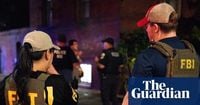In recent months, the debate over immigration enforcement in the United States has reached a fever pitch, with Portland, Oregon, emerging as a flashpoint. The city’s Immigration and Customs Enforcement (ICE) processing facility, located just south of downtown, has become a symbol of the national struggle over how to balance law enforcement, civil liberties, and the rights of immigrants. The facility has drawn national attention, not only for the protests that have taken place there since June 2025 but also for the political battles playing out between local, state, and federal officials.
According to the Oregon Capital Chronicle, Oregon’s congressional Democrats, including U.S. Representatives Suzanne Bonamici and Maxine Dexter and Senators Ron Wyden and Jeff Merkley, visited the Portland ICE facility on September 25, 2025. Their visit came after months of mostly small, peaceful protests outside the building—protests that, while generally nonviolent, have captured the attention of President Donald Trump and his administration. Trump has repeatedly called Portland a "war-ravaged" city and threatened to deploy National Guard troops to both the city and its ICE facility, framing the protests as attacks by "Antifa, and other domestic terrorists."
Concerns about the treatment of both immigrants and protestors at the facility have prompted action from Oregon’s Democratic delegation. After their visit, the lawmakers issued a joint statement expressing that they were "deeply concerned by the lack of oversight and accountability of ICE agents, including those operating out of the Macadam (Portland) facility." They described meetings with ICE officials as frustrating, noting that agency representatives failed to provide thorough or consistent answers to their questions about critical issues such as immigrants’ access to legal representation, the use of pepper bullets and tear gas against protestors, and protections for local residents affected by the ongoing unrest.
In response, on October 8, 2025, the delegation sent three separate letters demanding answers and transparency from key federal officials: Department of Homeland Security Secretary Kristi Noem, U.S. Attorney General Pam Bondi, and Erik Johnson, deputy field office director for ICE’s Seattle operations. Only the letter to Noem included a firm deadline for a response—October 22. Among the questions posed were specifics about the types of pepper bullets and tear gas being deployed, the criteria for their use, and the steps taken to mitigate harm to protestors and neighbors. They also sought clarity on reports of immigrants with legal status being detained, denied bond, or deported despite medical issues, and queried ICE’s standards for accountability—particularly regarding masked or unidentified agents and the agency’s difficulty filling a community relations position at the facility.
City officials, meanwhile, have also taken action. In September, they notified the facility’s private owner that ICE was likely violating its agreement with the city by detaining people longer than the permitted 12-hour limit. Records indicate that at least 25 overnight detentions occurred between October 1, 2024, and July 27, 2025. Portland Mayor Keith Wilson has responded to federal pressure by increasing police presence at the facility but has refused to create a security perimeter or restrict protest zones, as demanded by Secretary Noem. Noem, who made an unannounced visit to the facility on October 7, later appeared on Fox News, where she called Governor Tina Kotek, Mayor Wilson, and Police Chief Bob Day "a bunch of pansies" and threatened to send "four times the amount of federal officers" if her demands were not met. She also called for designated free speech zones to contain protests, a measure not adopted by local officials.
At a White House roundtable on antifascist groups the next day, Noem accused Oregon’s leaders of "covering up the terrorism that is hitting their streets." The rhetoric from both sides has only intensified the scrutiny on Portland’s handling of immigration enforcement and protest activity, with local officials walking a tightrope between upholding public safety and defending civil liberties.
Amid this political storm, the federal government has made sweeping claims about the dangers faced by ICE agents nationwide. In a September executive order, the White House insisted that assaults on ICE agents had risen by "more than 1,000 percent" since June 2025. However, a joint investigation by NPR and Colorado Public Radio (CPR) tells a different story. Their analysis of federal court records found only about a 25 percent increase in charges for assault against federal officers through mid-September compared to the previous year. While ICE agents have undeniably faced dangerous situations—including a July 4 plot in Alvarado, Texas, where 15 people were charged after firing on ICE agents and wounding a police officer, and other violent incidents in California, Omaha, and Texas—the data simply does not support the administration’s claim of a thousand-percent surge.
Requests by both NPR and CPR for data supporting the White House’s assertion have been met with silence or vague references to press releases. The Department of Homeland Security has repeatedly declined to provide underlying data or explain the methodology behind the "1,000 percent" figure. Instead, officials have sent links to prior press releases citing the same statistic, without further substantiation.
Former FBI agent Bob Pence, who spent three decades with the Bureau, warned of the dangers of exaggerating such claims. "There are a number of ramifications, if the public can't believe what law enforcement is saying then law enforcement probably can't depend on the cooperation of citizens to report information to them accurately," Pence told NPR. Denver immigration attorney Christine Hernandez echoed these concerns, noting that in some recent cases, federal prosecutors have been unable to provide evidence for their claims of gang affiliations or other charges, eroding trust in the justice system.
The data also shows that, while assaults on federal officers nationwide rose 74 percent in the last quarter—largely due to increased enforcement operations and related protests in Los Angeles—prosecutors have struggled to secure felony indictments in many protest-related cases. Many charges have been dismissed, reduced, or resolved through plea deals. In Colorado, for instance, employees of the Bureau of Prisons and Bureau of Indian Affairs have historically faced more assaults than ICE agents.
The case of Venezuelan immigrant Abraham Gonzalez-Romero in Denver, reported by NPR, illustrates the complexities of these prosecutions. Gonzalez-Romero was initially charged with attempted murder and assaulting a federal officer after an altercation with ICE agents, but prosecutors later dropped the assault charge as part of a plea deal, and there was no evidence presented to support claims that he was a gang member or had bitten an agent. His case, nonetheless, was cited in congressional hearings as emblematic of the dangers faced by ICE agents—despite the lack of supporting evidence.
Even former ICE officials acknowledge that many assaults, such as being punched or bitten, are often considered "part of the job" and may not always be reflected in court records. Scott Mechkowski, a former Deputy Field Office Director for ICE in New York City, told NPR that "the only people who fully collect the number of assaults on ICE officers is ICE," and that many incidents are not prosecuted as felonies or even recorded in public databases.
As Portland and other cities continue to grapple with the challenges of immigration enforcement, protest rights, and public safety, the need for transparency and honest communication from all levels of government has never been clearer. The ongoing disputes over data, tactics, and rhetoric underscore the complexities facing communities and officials alike as they navigate these turbulent times.


